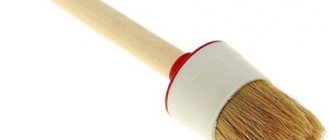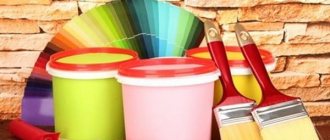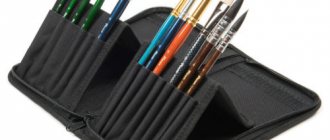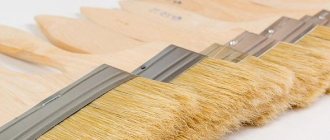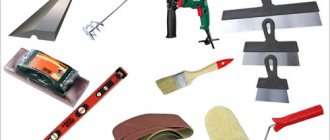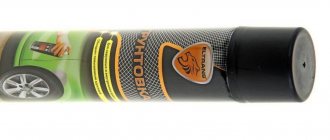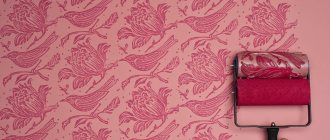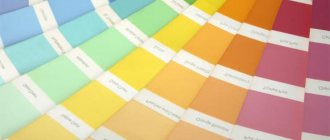Deciding to paint during a renovation is not easy. First you need to figure out one or more colors and lighting. Which paint is best suited is out of the question. But issues with brushes arise very rarely.
In fact, in vain. A properly selected brush made of high-quality bristles will not cause problems. A poor quality tool will not last long, and falling fluff will leave artistic scattering on a smooth surface. In order for the repair to go as planned, you need to understand which brush is best to choose for painting.
Types of tool pile
When choosing a brush, pay attention to the material of the bristles. She may be:
- Natural - pig or horse hair;
- Artificial - nylon, polyester fibers;
- Combined.
Natural
Natural bristles perfectly release the paint that they have absorbed and distribute it evenly over the surface to be painted. These qualities make brushes made from natural materials almost universal. However, the plus comes from the minus - such instruments will have to be changed more often than artificial ones.
Due to the absorption of watery paints and varnishes, the villi swell. Therefore, natural bristles will work better with enamel and other thick paintwork materials.
When choosing brushes for painting, it is better to immediately purchase a high-quality tool, that is, the price will be higher than the standard one, but it will last longer.
Pay attention to the thickness of the stubble. Manufacturers, in order to save long pile, combine it with short pile. The longest fibers take up more paint, which means the more of them, the better. Even in the photo, painting brushes with a good natural “brush” differ significantly from low-quality specimens.
Difficulty of choice
Naturally, when choosing a brush or roller for painting work, you should choose only high-quality and professional tools. In order to whitewash the ceiling in a utility room, of course, you can save money and buy a cheaper tool.
However, if you are going to paint or whitewash a living room, office or a high-traffic area, it is better to opt for a high-quality roller or brush. There are several reasons for this:
- When painting, a low-quality brush is almost guaranteed to leave lint on the walls. The same applies to rollers. In some cases, especially when using thick glazes, enamels or water-based paints, a problem with the quality of the coating is noticed too late to be able to change it. As the paint dries, it loses volume and air bubbles, protruding fibers or hairs begin to appear on the surface. It is better to immediately opt for a reliable brush or roller, so as not to encounter unexpected additional costs.
- Painting or whitening surfaces with professional tools is much more pleasant, faster and more convenient than using cheap analogues. Expensive brushes and rollers allow you to paint in a thick, even layer. This has an effect not only on the appearance of the ceiling or walls, but also on the life of the coating and its resistance to external factors.
- When painting, each task has its own specially designed roller or brush. Proper use of the tool will save you from large losses of paint that may fall on the floor, improve the quality of the finish, reduce material consumption, and help you complete complex painting work even without preparation.
Both tools can be used for painting work
Artificial
Nylon or polyester models are useful for watery paints, as they retain their shape while working. Only synthetics are used when painting latex-based paints. They are not exposed to water, their service life (with proper care) is much longer, and the length of the pile does not matter.
Making a synthetic brush involves “imitating” pig hair, that is, splitting each bristle tip into a scale-like pattern, which increases paint pick-up. However, the result is still different, so the paint fence is lower.
Combined
This type of paint brush combines the properties of both bristles. When working, the brush is elastic and firmly holds its shape. Suitable for working with paints of different “wateriness”, has optimal absorption and impact. A brush with combined bristles is indispensable when working with a variety of impregnations, stains and varnishes.
Depending on the surface, painting tools vary in shape:
- Flute;
- Round;
- Radiator;
- Maklovitsa.
Brush shape
Using very old brushes in order to save money is not very wise, since the size of the brush in this case matters.
It is better to use a wide brush and significantly reduce the time spent. You can use a small brush, but spend the whole day painting.
For small surfaces, it is better to use a small round brush. It will be much more convenient for her to work.
To paint round iron pipes, use a round brush, select it according to the size of the pipe and the painting process will be a pleasure for you.
There is no universal brush for all occasions; there is a brush for every type of work. Choosing the right brush will significantly reduce your working time.
Flute
The word “flutz” is usually used to refer to flat brushes; this type can most often be found in non-specialized stores. A variety of sizes are available upon purchase, but the bristle size is often standard – 60 mm.
Flat brushes are suitable for painting large surfaces, baseboards, window rails, window sills, etc.
Several brushes of different “dimensions” for all occasions can easily replace a set of various brushes, that is, they are not afraid of paints, varnishes, or enamels. Another advantage is that during operation the consumption of paint materials is saved, this allows you to paint more surfaces.
Bristle size
The next classification parameter is the size of the bristles. There are different sizes of paint brushes - narrow, medium, wide.
- Narrow brushes are those with a beam width of 1-3 cm. These brushes are convenient for painting thin elements and hard-to-reach places, drawing and applying decorative elements.
- Medium - brushes with bristles of 3.5 - 6 cm. Medium-sized brushes are used for painting doors, furniture, and window frames.
- Wide brushes usually have a width of 10 cm, so they are used for processing large surfaces.
Malkovitsa
They have their own varieties, but they all differ in their volumetric working surface. The shape can be rectangular, round or oval (for professional work) - each has an individual name. The handle of a standard malkovitsa is short, but in large construction hypermarkets it is possible to find a model with a long handle and better quality hair, which costs more.
Ideal for spacious painting, ceilings. The floor is also a large surface, but be careful: among the properties of these models is hyperabsorption, which makes painting with dense liquids unprofitable and costly.
But it works great with wallpaper glue and water-based paints.
Wood painting master class for beginners
One of the simplest items for creativity is a cutting board . This is where a budding artist can begin his journey.
To prepare the board for work and hide imperfections, you need to prime it. To do this, use potato starch or drying oil. Choose a simple pattern (flowers, leaves) to practice your skills. Transfer the image onto the surface using carbon paper. For the first work, choose gouache or acrylic. When painting boards, start with large details, then add color and move on to smaller elements. The last stage of work is coating with transparent varnish several times. Each subsequent layer is applied after the previous one has completely dried. After mastering the technique, you can move on to more complex objects to paint.
Round
Round brushes for painting are in less demand, but have the same advantages: they perfectly paint hard-to-reach corners, doorways, and windows. The disadvantage is the strong filling capacity, but the low yield of coatings. That is, too much liquid remains between the tufts of bristles - this reduces the effectiveness of painting work.
The working surface of this type can be large (the so-called flywheel) or small (ordinary). Swing tools are similar to malkovits - they are common when processing large areas. The diameter ranges from 60-65 mm.
To sum it up, we can say that choosing the right brushes and brushes is on par with the choice of paints and varnishes.
Quick-drying, odorless paint for interior work - main types, selection tips and benefits of useThe best aerosol paint in cans - main types, application features and advantages of use
The best water-based paint - ranking of the best manufacturers of 2018
Buying a flat brush for painting or a round one is more of an individual preference than a necessity.
Look at the fibers in the store and definitely buy them if:
- When deliberately pulling out hairs, no more than two pieces remain in the fingers.
- A convenient cut is a long center, shortening towards the edges. This makes it easier to control the distribution of liquids.
- By pressing on the structure of the bristles and then releasing them, they return to their original state.
Finally, just feel the handle in your fingers. The brush will last for many years, which means it is convenient
How to choose?
There is an impressive range of paint brushes available in hardware stores and specialty outlets. It will be difficult for a beginner who is thinking about buying for the first time to make the right choice.
Expert advice is intended to make the task easier.
- There is no universal brush. Painting work will require the contractor to purchase several tools. For example, to paint large surfaces you need a swing brush, and to cut a coating you need a flute brush. It is more convenient to handle corners manually or with paneling. Having decided on future events, they purchase the most suitable ones. It is possible to purchase a set of paint brushes, including from 3 to 10 products of different diameters and shapes.
- Examine the handle. Made from plastic and wood. The latter is a budget option. Lacquered handles are not recommended. Since they are not able to provide proper grip. During work, they will constantly slip out of the palm of your hand and cause inconvenience. Those with a plastic handle are more expensive. This material does not get wet and does not dry out over time; it is easy to clean from dirt and, with proper care, lasts a long time. The handle can be long or short. Compatible with special extension cord. Regardless of the material chosen, it is important to ensure that the handle fits snugly and does not wobble. Special attention is paid to how it lies in the hand. Working with an inconvenient tool will cause additional difficulties.
- Bristle. Natural, artificial and combined. Each is suitable for performing specific tasks. It is important to check the elasticity before purchasing. To do this, bend it at a slight angle and release it. A quality item will return to its original condition. Deformation indicates that it is better to avoid this product. The villi are evenly distributed over the entire area and do not fall out. The ends don't split. You can do a small test in the store. If, after twitching, the bundle begins to delaminate and part falls out, the product is not of good quality.
- Beam density. It is called the number “tols”. The higher the better. The indicator indicates how effectively the tool holds paint or varnish. They have high return rates.
- Adhesive composition. Epoxy glue is preferred. It retains its qualities for a long time. By keeping the fibers in one place, it improves the quality of the surface finish.
- Frame. The most common is steel bandage. This was facilitated by such qualities as strength and resistance to organic solvents. Despite this, brass ones are considered reliable. This is due to the fact that the material is practically not susceptible to corrosion and does not rust. Plastic frames are also available. They do not rust, but contact with some solvents leads to loss of shape.
Photos of paint brushes?
How to choose façade paint for exterior use - a review of popular manufacturers and a rating of the best paints for exterior use- Which oil paint is better - a review of the best brands and criteria for selecting paints
The best interior paint for walls - 2022 rating and instructions for using interior paint
